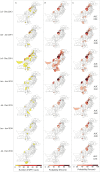Risk factors and short-term projections for serotype-1 poliomyelitis incidence in Pakistan: A spatiotemporal analysis
- PMID: 28604777
- PMCID: PMC5467805
- DOI: 10.1371/journal.pmed.1002323
Risk factors and short-term projections for serotype-1 poliomyelitis incidence in Pakistan: A spatiotemporal analysis
Abstract
Background: Pakistan currently provides a substantial challenge to global polio eradication, having contributed to 73% of reported poliomyelitis in 2015 and 54% in 2016. A better understanding of the risk factors and movement patterns that contribute to poliovirus transmission across Pakistan would support evidence-based planning for mass vaccination campaigns.
Methods and findings: We fit mixed-effects logistic regression models to routine surveillance data recording the presence of poliomyelitis associated with wild-type 1 poliovirus in districts of Pakistan over 6-month intervals between 2010 to 2016. To accurately capture the force of infection (FOI) between districts, we compared 6 models of population movement (adjacency, gravity, radiation, radiation based on population density, radiation based on travel times, and mobile-phone based). We used the best-fitting model (based on the Akaike Information Criterion [AIC]) to produce 6-month forecasts of poliomyelitis incidence. The odds of observing poliomyelitis decreased with improved routine or supplementary (campaign) immunisation coverage (multivariable odds ratio [OR] = 0.75, 95% confidence interval [CI] 0.67-0.84; and OR = 0.75, 95% CI 0.66-0.85, respectively, for each 10% increase in coverage) and increased with a higher rate of reporting non-polio acute flaccid paralysis (AFP) (OR = 1.13, 95% CI 1.02-1.26 for a 1-unit increase in non-polio AFP per 100,000 persons aged <15 years). Estimated movement of poliovirus-infected individuals was associated with the incidence of poliomyelitis, with the radiation model of movement providing the best fit to the data. Six-month forecasts of poliomyelitis incidence by district for 2013-2016 showed good predictive ability (area under the curve range: 0.76-0.98). However, although the best-fitting movement model (radiation) was a significant determinant of poliomyelitis incidence, it did not improve the predictive ability of the multivariable model. Overall, in Pakistan the risk of polio cases was predicted to reduce between July-December 2016 and January-June 2017. The accuracy of the model may be limited by the small number of AFP cases in some districts.
Conclusions: Spatiotemporal variation in immunization performance and population movement patterns are important determinants of historical poliomyelitis incidence in Pakistan; however, movement dynamics were less influential in predicting future cases, at a time when the polio map is shrinking. Results from the regression models we present are being used to help plan vaccination campaigns and transit vaccination strategies in Pakistan.
Conflict of interest statement
I have read the journal's policy and the authors of this manuscript have the following competing interests: ASB is employed with the study funder (Bill & Melinda Gates Foundation) and was involved in study design, interpretation, and writing of the report. The funder had no role in data collection.
Figures





References
-
- GPEI. Data and monitoring. Wild poliovirus. [26 January 2017]. Available from: http://www.polioeradication.org/Dataandmonitoring/Poliothisweek/Wildpoli....
-
- Owais A, Khowaja AR, Ali SA, Zaidi AK. Pakistan's expanded programme on immunization: an overview in the context of polio eradication and strategies for improving coverage. Vaccine. 2013;31(33):3313–9. doi: 10.1016/j.vaccine.2013.05.015 - DOI - PubMed
-
- WHO. The Polio Eradication & Endgame Strategic Plan 2013–2018.2013.
-
- Chang AC, E.; Hameed S.; Lamb R.; Mixon R. Eradicating Polio in Afghanistan and Pakistan. A Report of the CSIS Global Health Policy Center. Center for Strategic & International Studies; 2012.
-
- Garon JR, Orenstein WA. Overcoming barriers to polio eradication in conflict areas. Lancet Infect Dis. 2015;15(10):1122–4. doi: 10.1016/S1473-3099(15)00008-0 - DOI - PubMed
MeSH terms
Grants and funding
LinkOut - more resources
Full Text Sources
Other Literature Sources
Medical

